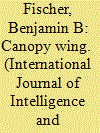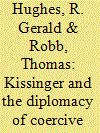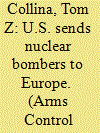| Srl | Item |
| 1 |
ID:
132418


|
|
|
|
|
| Publication |
2014.
|
| Summary/Abstract |
Although Winston Churchill declared that history is always written by the victors, never the vanquished, a group of former East German foreign intelligence officers seem determined to prove him wrong. Calling themselves Insiders have been churning out books since the end of the Cold War that recount the history of that conflict from their perspective. The Insiders' mantra is that they were on the right, even if losing, side because they "spied for peace" to protect the Warsaw Pact against the existential threat posed by the "aggressive intentions" of the West.
|
|
|
|
|
|
|
|
|
|
|
|
|
|
|
|
| 2 |
ID:
131454


|
|
|
|
|
| Publication |
2013.
|
| Summary/Abstract |
The majority of scholarly accounts suggest that Anglo-Americans throughout the era of détente, 1969-1977, were often fraught with difficulties. In particular, the relationship between the Nixon administration and the British government of Edward Heath is often seen as the nadir for the Anglo-American relationship during the Cold War. Nonetheless, elements of the Anglo-American "special relationship," particularly those related to intelligence and nuclear co-operation, are often seen by scholars to have operated outside of these wider political difficulties. By utilising recently declassified documentation from both U.S. and UK archives, it is shown that both intelligence and nuclear co-operation were continually used by the United States as a means of convincing London to follow more amenable policy lines. With Henry Kissinger very much to the fore, it is illustrated how this coercive diplomacy had mixed results in achieving what Washington desired. Ultimately, this policy line would not accomplish what its main adherent, Henry Kissinger, sought.
|
|
|
|
|
|
|
|
|
|
|
|
|
|
|
|
| 3 |
ID:
132789


|
|
|
|
|
| Publication |
2014.
|
| Summary/Abstract |
The U.S. Air Force sent five nuclear-capable bombers to Europe in early June as President Barack Obama traveled to the region to reassure allies against the backdrop of Russia's recent annexation of Crimea and separatist conflict in Ukraine.
All five bombers went to the air force base at Fairford in the United Kingdom. Two B-52 bombers from Barksdale Air Force Base in Louisiana and one from Minot Air Force Base in North Dakota arrived on June 4 for a two-week deployment, according to an Air Force press release. "Airmen will train and integrate with U.S. and allied military forces in the region," the Air Force said, adding that the bombers did not carry live weapons.
Four days later, two B-2 bombers based at Whiteman Air Force Base in Missouri flew to Fairford as well, the Air Force said. As the most sophisticated U.S. bomber for penetrating enemy air defenses, the presence in Europe of nuclear-capable B-2s was reported by media outlets as possibly sending a pointed message to Moscow.
|
|
|
|
|
|
|
|
|
|
|
|
|
|
|
|